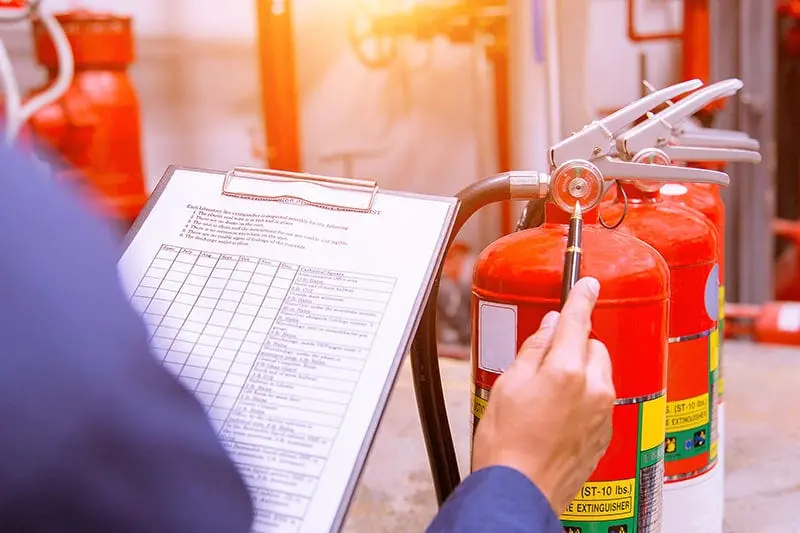In high-risk areas, fire safety measures are not just precautionary; they are essential for safeguarding lives and properties. Did you know that a single fire can cause millions in damages and disrupt communities? This article is designed for property managers, business owners, and safety officers who face the daunting challenge of preventing devastating fires. We will explore how thorough fire risk assessments can pinpoint hazards and prioritize risks, ensuring that your environment is as secure as possible. You’ll learn about the importance of installing advanced detection systems, such as infrared and smoke sensors, for timely alerts, and how effective fire suppression systems paired with regular maintenance can be game-changers. Additionally, we’ll discuss the necessity of developing clear emergency response plans and the value of conducting biannual drills. With regular employee training and the integration of IoT for enhanced safety monitoring, you can create a robust fire safety strategy. Join us as we dive deeper into implementing fire safety measures in high-risk areas to protect what matters most.
Conducting Comprehensive Fire Risk Assessments
How should you conduct effective fire risk assessments?
To conduct effective fire risk assessments, begin by identifying potential hazards such as flammable materials, outdated electrical systems, and heat sources.
Evaluate these risks to prioritize areas with higher danger levels. Compliance with the National Fire Protection Association’s regulatory standards is crucial to ensure safety requirements are met.
- Document findings for compliance audits and safety references.
- Regularly review and update assessments to adapt to operational changes.
- Maintain ongoing training for staff on fire safety protocols.
Continual evaluations and documentation help protect your workplace from fire threats. Additionally, ensure you assess likelihood and potential severity to better understand risk levels.
For more detailed guidelines, see our comprehensive guide on fire safety best practices.
Installing Advanced Fire Detection Systems
Installing advanced fire detection systems significantly improves safety by enabling early detection of fires through state-of-the-art sensor technologies. But how can regular maintenance ensure the ongoing reliability of these crucial systems? Understanding the importance of upkeep is essential for compliance and optimal protection of lives and assets. Regular maintenance and calibration ensure system reliability, which is critical in environments with flammable gases to prevent disasters.
Early Fire Detection Importance
How can early fire detection systems protect high-risk areas?
Early fire detection systems are crucial in minimizing risks in high-risk environments. Reliable smoke and heat detectors significantly enhance safety by ensuring rapid identification of fire hazards, which can drastically lower response times.
- Implement Automated Alarms: Essential in industries like chemical plants, automated systems allow for swift detection of fire threats.
- Conduct Regular Testing: Following NFPA guidelines, ensure systems are tested monthly and undergo annual inspections for optimal performance.
- Utilize IoT Integration: Connecting detection systems with emergency response teams facilitates quicker interventions.
Advanced Sensor Technologies
How are advanced sensor technologies transforming fire detection?
Advanced sensor technologies are revolutionizing fire detection, especially in high-risk environments like chemical plants and oil refineries. By leveraging systems such as infrared sensors, smoke detectors, and heat sensors, organizations can achieve quicker response times through automated fire alarm systems that alert emergency teams immediately.
To ensure effectiveness, regular maintenance—ideally twice a year—is crucial.
Additionally, integrating data analytics enhances risk assessment and informs safety protocols, allowing for proactive fire prevention strategies.
- Implement regular system checks.
- Utilize real-time environmental monitoring.
- Analyze data for tailored safety measures.
For further insights into optimizing fire safety protocols, check out our comprehensive guide on emergency response strategies.
System Integration Benefits
How can integrating fire detection systems enhance safety in high-risk areas?
Integrating advanced fire detection systems is essential for enhancing safety in high-risk environments. By connecting smoke and heat detectors with emergency response teams, organizations can ensure immediate alerts, which significantly shortens response times.
This system integration not only boosts coordination but also improves overall safety infrastructure.
- Implement automated fire alarm connectivity for swift notifications.
- Utilize real-time monitoring with flame detectors to identify potential ignition sources.
- Regularly maintain and test systems to ensure they function effectively during emergencies.
These strategies create a robust framework for managing fire risks efficiently.
For further insights on fire safety measures, see our guide on effective emergency response planning.
Utilizing Effective Fire Suppression Systems
How can effective fire suppression systems enhance safety in high-risk areas?
Implementing robust fire suppression systems is essential for minimizing damage and ensuring safety in high-risk environments.
Automatic sprinklers can decrease fire-related losses by as much as 70% when properly installed and maintained. Additionally, gas-based systems like CO2 and FM-200 are crucial for safeguarding sensitive equipment in data centers without risking water damage.
To maintain optimal performance, regular inspections and maintenance are critical. The NFPA suggests conducting checks at least annually to ensure readiness. Furthermore, adherence to safety codes and regulations is vital for compliance and effective fire protection.
Prioritizing these measures not only protects property but also saves lives.
For further insights on enhancing fire safety, consider exploring our guide on fire prevention strategies.
Ensuring Proper Placement of Fire Extinguishers
How can proper fire extinguisher placement enhance safety?
Effective placement of fire extinguishers significantly boosts safety in high-risk environments. By positioning them within 30 feet of potential hazards, such as kitchens or workshops, individuals can quickly access them in emergencies.
Furthermore, mounting extinguishers between 3.5 to 5 feet off the ground ensures they’re visible and unobstructed.
To maximize safety, consider the following:
- Use Class K extinguishers in kitchens to combat specific fire risks.
- Regularly inspect extinguishers to ensure they’re charged and undamaged.
- Post clear signage to indicate the type and proper use of each extinguisher.
- Regular inspections are crucial for ensuring proper functionality of extinguishers during emergencies.
For more detailed information on fire safety practices, check our guide on emergency preparedness.
Developing Emergency Response and Evacuation Plans
Establishing clear evacuation procedures and emergency assembly points is crucial for safety during emergencies.
But how can you ensure that everyone is adequately prepared for a swift response?
Understanding the importance of regular fire drills can significantly enhance the effectiveness of your emergency response and evacuation plans. Regular assessments of fire hazards contribute to a safer work environment and better preparedness.
Clear Evacuation Procedures
How can organizations ensure effective evacuation procedures during emergencies?
Establishing efficient evacuation procedures is vital for safeguarding individuals in high-risk situations. To ensure readiness, organizations should conduct regular fire drills. This practice not only familiarizes everyone with emergency protocols but also cultivates a responsive mindset in real scenarios.
Additionally, assigning specific roles, such as fire wardens, can streamline the evacuation process. These appointed individuals help maintain order and ensure compliance with established evacuation routes.
Moreover, installing illuminated signage will guide occupants to safety and minimize confusion during an emergency.
- Conduct fire drills regularly.
- Appoint fire wardens for coordination.
- Use illuminated signs to mark exits.
For further insights on enhancing safety protocols, explore our guide on emergency communication systems.
Emergency Assembly Points
How can organizations effectively establish emergency assembly points?
To ensure a robust safety plan, organizations must strategically designate emergency assembly points away from potential fire hazards. These locations should be easily accessible for all employees during an evacuation. Clearly marked and illuminated signs enhance visibility, minimizing confusion during emergencies.
- Regularly conduct drills to familiarize staff with assembly procedures.
- Assign roles to fire wardens or safety officers to manage these points.
- Implement communication systems, such as public address systems, to guide personnel efficiently.
Regular Fire Drills
How can organizations enhance their fire safety plans through regular drills?
To improve fire safety protocols, organizations should conduct fire drills at least biannually.
These drills not only familiarize employees with evacuation routes but also help reduce anxiety during emergencies. By simulating realistic scenarios, staff can practice their responses, enhancing overall efficiency in evacuations.
- Assign fire wardens to oversee the drills.
- Gather feedback through post-drill evaluations to refine protocols.
- Ensure alarms and signage are clearly communicated to all employees.
Implementing these strategies will bolster your organization’s preparedness.
For more insights on improving workplace safety, refer to our comprehensive guide on emergency preparedness.
Providing Regular Training for Employees
How can companies effectively prepare employees for fire emergencies?
Preparing employees for fire emergencies involves regular, specialized training that addresses the specific risks associated with their work environment.
Regular, specialized training is essential for preparing employees for fire emergencies in their specific work environment.
Companies should assess potential fire hazards, such as combustible materials and outdated electrical systems, to enhance awareness and safety measures.
Implementing hands-on training with various fire extinguishers and conducting biannual evacuation drills help familiarize staff with emergency protocols.
- Conduct regular fire safety audits.
- Offer refresher courses to keep knowledge up-to-date.
- Foster an open dialogue about fire safety concerns.
Incorporating fire suppression tools into training sessions enables employees to gain practical experience and confidence in handling emergencies.
By prioritizing these strategies, businesses can cultivate a safer workplace and empower employees to respond confidently during emergencies.
For more information on effective training techniques, refer to our comprehensive guide on employee safety training.
Leveraging Technology for Improved Fire Safety
How can technology improve fire safety measures?
Technology significantly enhances fire safety by enabling proactive monitoring and rapid response. Integrating IoT devices into fire safety systems allows for real-time tracking of temperature and gas levels, which improves early detection of potential hazards. This innovation leads to more effective fire prevention strategies and minimizes damage during emergencies.
- Automated Fire Suppression: Systems release extinguishing agents automatically, expediting damage control.
- Remote Monitoring: Manage multiple high-risk locations from a distance for quicker interventions.
- Data Analytics: Use historical data to refine safety protocols and identify trends in fire risks.
These advancements create a safer environment. Additionally, modern firefighting strategies rely heavily on real-time data collection and analysis to enhance situational awareness. To explore more on optimizing fire safety, check out our guide on modern fire prevention strategies.
Frequently Asked Questions
What Are the 4 P’s of Fire Safety?
FAQ
Q: What are the 4 P’s of fire safety? A: The 4 P’s of fire safety include Prevention, Protection, Preparedness, and Response, which are essential for minimizing fire risks.
Q: How can I improve fire prevention? A: Enhance fire prevention through risk assessments, training, and using safety equipment to reduce potential hazards.
Q: What does fire protection involve? A: Fire protection involves measures like installing fire alarms and sprinklers to safeguard lives and property from fire.
Q: Why is preparedness important in fire safety? A: Preparedness ensures that individuals and communities are ready to act during a fire emergency, improving response effectiveness.
Q: What actions are part of fire response? A: Fire response includes executing evacuation plans, conducting drills, and following safety regulations during an emergency.
Q: How do the 4 P’s of fire safety relate to community awareness? A: The 4 P’s of fire safety enhance community awareness by promoting education, training, and compliance, leading to safer environments.
What Safety Measures Should Be Used for Fire and Disaster Situations?
FAQ
Q: What are effective safety measures for fire situations? A: Effective safety measures include installing smoke detectors, conducting fire drills, and ensuring clear evacuation routes.
Q: How can I prepare for disaster situations? A: Preparing for disaster situations involves creating an emergency plan, training staff, and having essential supplies ready.
Q: Why is conducting risk assessments important for fire safety? A: Risk assessments help identify potential hazards, allowing you to implement effective safety measures for fire situations.
Q: What building materials are best for fire safety? A: Using fire-resistant materials, such as concrete or metal, enhances safety measures for fire situations.
Q: How often should fire drills be practiced? A: Regular practice of fire drills, ideally every six months, ensures everyone is familiar with safety measures for fire situations.
Q: What role do fire alarms play in safety measures? A: Fire alarms are crucial safety measures, alerting occupants to fire situations and allowing for timely evacuations.
What Are the 5 Principles of Fire Safety?
FAQ
Q: What are the main principles of fire safety? A: The five principles of fire safety include prevention strategies, installation of smoke detectors, emergency exit planning, conducting fire drills, and training with fire extinguishers.
Q: How can I implement fire prevention strategies? A: Implement fire prevention strategies by storing flammable materials safely, identifying hazards, and conducting regular fire safety audits.
Q: Why are smoke detectors important for fire safety? A: Smoke detectors are crucial for fire safety as they provide early warnings, allowing occupants to evacuate promptly in case of a fire.
Q: How often should we conduct fire drills? A: Fire drills should be conducted regularly, at least twice a year, to ensure everyone knows the evacuation routes and procedures in case of a fire.
Q: What should I include in my emergency exit plan? A: Your emergency exit plan should include clearly marked evacuation routes, assembly points, and procedures for assisting individuals with disabilities during a fire.
Q: How can training with fire extinguishers improve fire safety? A: Training with fire extinguishers ensures that individuals know how to use them correctly, enhancing overall fire safety and preparedness in emergency situations.
What Are the Four 4 Safety Measures Usually Stated in a Fire Emergency Plan?
FAQ
Q: What are the key components of a fire emergency plan? A: A fire emergency plan typically includes evacuation routes, fire drills, alarm systems, and communication plans.
Q: How do I ensure safety in a fire emergency? A: Ensure safety by implementing fire extinguishers, regular fire drills, clear safety signage, and thorough training programs.
Q: Why are fire drills important in a fire emergency plan? A: Fire drills prepare individuals for real emergencies, ensuring everyone knows evacuation routes and procedures, enhancing overall safety.
Q: What role do fire extinguishers play in a fire emergency plan? A: Fire extinguishers are essential tools for immediate fire response, helping to control small fires before they escalate.
Q: How can I improve communication during a fire emergency? A: Establish a clear communication plan with emergency contacts to relay information quickly and effectively during a fire emergency.
Conclusion
In high-risk areas, prioritizing fire safety measures is essential for protecting lives and property. By implementing strategies such as rigorous fire risk assessments and advanced detection systems, you can significantly minimize fire threats and enhance overall safety. These proactive steps not only safeguard your environment but also ensure a swift response during emergencies, ultimately saving time and resources. Consider exploring more tips on fire safety or reading a related guide to deepen your understanding and preparedness. Taking these steps today can make a world of difference tomorrow.


